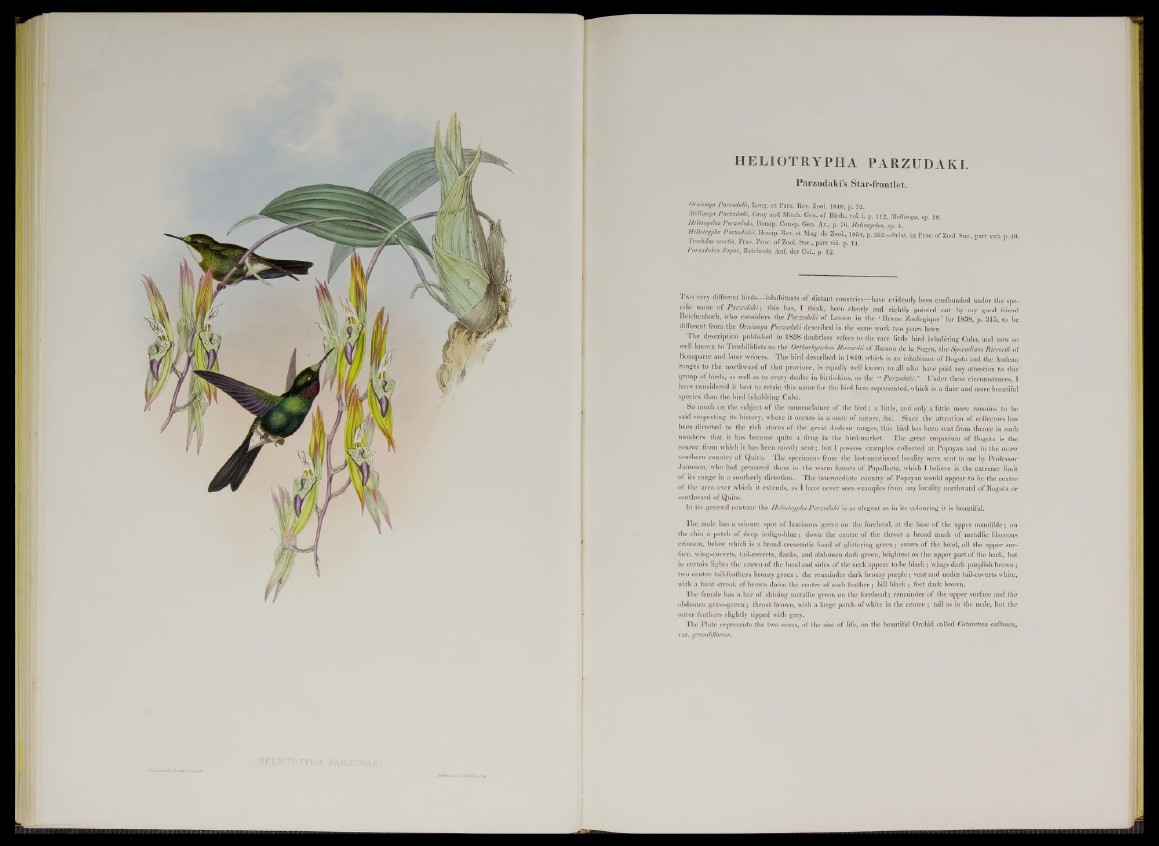
HELIOTRYPHA PARZUDAKI .
Parzudaki’s Star-frontlet.
Omimya Parzulaki, Long, et Para. Rev. Zool. 1840, p. 72. Mellisuga Parzudaki, Gray and Mitch. Gen. of Birds, vol. i. p. 112, Mellimga, sp. 18. Helmngclm Parzulaki, Bonap. Consp. Gen. Av., p. 76, Heliamjclm, sp. 4. Heliotrypha Parzudakii, Bonap. Rev. et Mag. de Zool., 1854, p. 2 5 2 ,-S c la t in Proc. of Zool. Soc„ p art xxn. p. 40. Trochilus exortis, Fras. Proc. of Zool. Soc., p art vin. p. 14. Parzudakia dispar, Reichenb. Auf. der Col., p. 12.
Two very different birds—inhabitants of distant countries—have evidently been confounded under the specific
name of Parzudaki; this has, I think, been, clearly and rightly pointed out by my good friend
Reichenbach, who considers the Parzudaki of Lesson in the ‘Revue Zoologique’ for 1838, p. 315, to be
different from the Ornismya Parzudaki described in the same work two years later.
The description published in 1838 doubtless refers to the rare little bird inhabiting Cuba, and now so
well known to Trochilidists as the Orthorhynchus Riccordii of Ramon de la Sagra, the Sporadinus Riccordi of
Bonaparte and later writers. The bird described in 1840, which is an inhabitant of Bogota and the Andean
ranges to the northward of that province, is equally well known to all who have paid any attention to this
group of birds, as well as to every dealer in bird-skins, as the “ Parzudaki.” Under these circumstances, I
have considered it best to retain this name for the bird here represented, which is a finer and more beautiful
species than the bird inhabiting Cuba.
So much on the subject of the nomenclature of the bird; a little, and only a little more remains to be
said respecting its history, where it occurs in a state of nature, &c. Since the attention of collectors has
been directed to the rich stores of the great Andean ranges, this bird has been sent from thence in such
numbers that it has become quite a drug in the bird-market. The great emporium of Bogota is the
source from which it has been mostly sen t; but I possess examples collected at Popayan and in the more
southern country of Quito. The specimens from the last-mentioned locality were sent to me by Professor
Jameson, who had procured them in the warm forests of Papallacta, which I believe is the extreme limit
of its range in a southerly direction. The intermediate country of Popayan would appear to be the centre
of the area over which it extends, as I have never seen examples from any locality northward of Bogota or
southward of Quito.
In its general contour the Heliotrypha Parzudaki is as elegant as in its colouring it is beautiful.
The male has a minute spot of luminous green on the forehead, at the base of the upper mandible; on
the chin a patch of deep indigo-blue; down the centre of the throat a broad mark of metallic filaceous
crimson, below which is a broad crescentic band of glittering green; crown of the head, all the upper surface,
wing-coverts, tail-coverts, flanks, and abdomen dark green, brightest on the upper part of the back, but
in certain fights the crown of the head and sides of the neck appear to be black; wings dark purplish brown;
two centre tail-feathers bronzy green ; the remainder dark bronzy purple; vent and under tail-coverts white,
with a faint streak of brown down the centre of each feather; bill black ; feet dark brown.
The female has a bar of shining metallic green 011 the forehead; remainder of the upper surface and the
abdomen grass-green; throat brown, with a large patch of white in the centre ; tail as in the male, but the
outer feathers slightly tipped with grey.
The PI ate represents the two sexes, of the size of fife, on the beautiful Orchid called Catasetum callosum,
var. grandi/lorwn.